Executive Summary
As the vaccination count continues to rise and the new case count for the coronavirus continues to decline, more and more people – including financial advisors – are beginning to emerge from the shutdown and return to ‘life as normal’, which means a return to school, a return to the office… and now that summer is arriving, a return to the family trip and summer vacation. Which means some downtime for rest and relaxation. And for many, that includes finding some time to read and catch up on a few good books!
For those who love a good book, though (and especially for those who have limited time and will only get to read a few), the question quickly becomes “what’s a good book worth reading these days?” As a voracious reader myself, I'm always eager to hear suggestions from others of great books to read, whether it's something new that's just come out, or an "old classic" that I should go back and read (again or for the first time!). And so, in the spirit of sharing, a few years ago I launched my list of "Recommended (Book) Reading for Financial Advisors", and it was so well received that in 2013 I also started sharing my annual "Summer Reading List" for financial advisors of the best books I'd read in the preceding year. It quickly became a perennial favorite on Nerd's Eye View, and so I've updated it every year, with new lists of books in 2014, 2015, 2016, 2017, 2018, 2019, and a fresh round last year in 2020.
And now, I'm now excited to share my latest Summer Reading list of top books for financial advisors in 2021, including some suggestions from our growing ‘team of nerds’ here at Kitces.com, from a deep dive into how helping clients with their money psychology can impact their wealth more so than ‘just’ the technical financial planning advice, why it’s so important to create time and space for the “Deep Work” that adds the most value, what the financial advice business can learn from the restaurant hospitality business, why the long-term key to building a successful business is not about maximizing your own skills and productivity but in finding the “Whos” that can help turn your ideas into reality (and then how to get the most out of the people on your team), what it takes to be more relevant for prospective clients and how to get them to actually see your value as a financial planner (hint: stop telling them about the value of your financial planning advice, and just start giving them financial planning advice that they’ll only want more of!), and some great guidance on how to not just have more answers for clients but how to ask better questions (replete with a list of actual questions to try out with your clients!).
So as the summer season gets underway, and summer vacations return, I hope that you find this suggested summer reading list of books for financial planners to be helpful… and please do share your own suggestions in the comments at the end of the article about the best books you've read over the past year as well!
Financial Planner Book List For 2021 Summer Reading
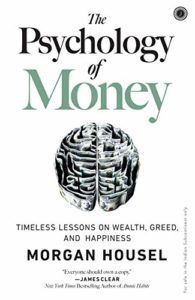 The Psychology Of Money: Timeless Lessons On Wealth, Greed, And Happiness (Morgan Housel) – One of the implicit teachings of the CFP curriculum is that with enough technical knowledge, and sufficient access to tools to conduct the appropriate analyses, anyone’s financial situation can be “solved”, and their goals achieved, with the right recommendations. But then once we begin working with clients directly, it becomes clear that how clients act, the decisions they make, and whether and how they even implement the recommendations, often has far more of an impact on the outcomes than the accuracy of the advice itself. For instance, Housel tells the story of a ‘wildly successful’ multi-millionaire executive, who founded and sold multiple tech startups, and once bought $1,000 gold coins to literally throw away by tossing them like skipping stones into the Pacific Ocean (and not surprisingly, eventually ended out broke)… as contrasted with Ronald Read, who fixed cars at a gas station for 25 years and then swept floors at JC Penney for 17 years, ultimately passing away at age 92 and leaving a whopping $8M estate behind (the majority of which the janitor and gas station attendant ultimately left to charity). The $8M difference between the tech entrepreneur and the janitor wasn’t a result of who got the better and more technically accurate financial advice; instead, as Morgan Housel – who has written about personal finance for more than a decade – notes, “financial success is not a hard science. It’s a soft skill, where how you behave is more important than what you know.” In the financial services industry, this has resulted in a growing focus on “behavioral finance”, but as Housel illustrates in his book, the real money challenges are not just about a series of ‘behavioral biases’ that economists have discovered, but an extension of human psychology itself. In one chapter after another, Housel tells the stories of real people, the decisions they make with money, and illustrates how our psychology can either lift our financial success or wreak havoc upon it. Ultimately, the Psychology of Money is written for consumers as a way for them to glean insights into how to think about their own money psychology, but financial advisors will see their own clients reflected in many of the chapters… and in the process, get armed with new ideas and new ways to talk about common money psychology challenges with clients, from why compounding is so powerful (did you know that $81.5B of Warren Buffett’s $84.5B net worth came after he turned age 65!?), to the challenges of engaging in long-term planning (because in practice, our goals and desires change over time!), to the difference between Getting Wealthy and Staying Wealthy (because the skills it takes to create wealth are different from what it takes to hold on to it!).
The Psychology Of Money: Timeless Lessons On Wealth, Greed, And Happiness (Morgan Housel) – One of the implicit teachings of the CFP curriculum is that with enough technical knowledge, and sufficient access to tools to conduct the appropriate analyses, anyone’s financial situation can be “solved”, and their goals achieved, with the right recommendations. But then once we begin working with clients directly, it becomes clear that how clients act, the decisions they make, and whether and how they even implement the recommendations, often has far more of an impact on the outcomes than the accuracy of the advice itself. For instance, Housel tells the story of a ‘wildly successful’ multi-millionaire executive, who founded and sold multiple tech startups, and once bought $1,000 gold coins to literally throw away by tossing them like skipping stones into the Pacific Ocean (and not surprisingly, eventually ended out broke)… as contrasted with Ronald Read, who fixed cars at a gas station for 25 years and then swept floors at JC Penney for 17 years, ultimately passing away at age 92 and leaving a whopping $8M estate behind (the majority of which the janitor and gas station attendant ultimately left to charity). The $8M difference between the tech entrepreneur and the janitor wasn’t a result of who got the better and more technically accurate financial advice; instead, as Morgan Housel – who has written about personal finance for more than a decade – notes, “financial success is not a hard science. It’s a soft skill, where how you behave is more important than what you know.” In the financial services industry, this has resulted in a growing focus on “behavioral finance”, but as Housel illustrates in his book, the real money challenges are not just about a series of ‘behavioral biases’ that economists have discovered, but an extension of human psychology itself. In one chapter after another, Housel tells the stories of real people, the decisions they make with money, and illustrates how our psychology can either lift our financial success or wreak havoc upon it. Ultimately, the Psychology of Money is written for consumers as a way for them to glean insights into how to think about their own money psychology, but financial advisors will see their own clients reflected in many of the chapters… and in the process, get armed with new ideas and new ways to talk about common money psychology challenges with clients, from why compounding is so powerful (did you know that $81.5B of Warren Buffett’s $84.5B net worth came after he turned age 65!?), to the challenges of engaging in long-term planning (because in practice, our goals and desires change over time!), to the difference between Getting Wealthy and Staying Wealthy (because the skills it takes to create wealth are different from what it takes to hold on to it!).
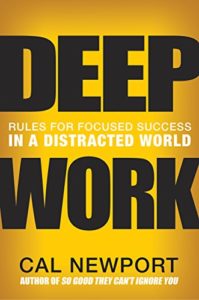 Deep Work: Rules For Focused Success In A Distracted World (Cal Newport) – One of the most striking tendencies of some of the most prolific authors and creators is the amount of time they spend sequestering themselves from the rest of the world, from the private office of psychologist Carl Jung (where he would spend 2 hours every morning on undistracted writing) to Mark Twain writing much of The Adventures of Tom Sawyer from a shed (where he was so isolated that his family had to blow a horn to get his attention at mealtime) to Woody Allen writing 44 films (earning 23 Academy Award nominations) from a manual typewriter (right up through 2013, decades after personal computers were available). In essence, these creators were especially good at creating space for themselves to do “Deep Work” – the kinds of “professional activities performed in a state of distraction-free concentration that push your cognitive capabilities to their limit” that are the very essence of what creates value and is hardest to replicate in the modern era. In fact, the irony is that even as such human “Deep Work” is becoming more valuable than ever – the last bastion of value-add on top of what technology is increasingly automating – the ubiquity of smartphones and the accessibility of technology is making it increasingly rare for us to actually find the time and create the space for such Deep Work. Which just makes it all the more valuable for those who can create that time and space for themselves. Accordingly, Newport provides a wide range of tactics and techniques to help us all create more room on our calendars for the Deep Work, starting with actually putting that time on the calendar to do Deep Work, spacing the “Shallow Work” around it, quitting the activities that don’t actually contribute to business outcomes (e.g., idle social media chatter!?), and recognizing that the human brain is only capable of a very limited amount of Deep Work at a time (for most people, no more than 2-4 hours in a day). In the advisor context, scheduling Deep Work could be putting time on the calendar to write an article or produce a video for client education or marketing purposes, or crafting a client’s financial plan, or the focused meeting time to have productive meetings with clients (even or especially clumped into Meeting Surges that allow us to focus the time). Which in turn can help get the most important work done not just better but quicker (with the additional focus), ultimately freeing up more time (either to do more, or simply to create space for rest and downtime before the next surge). The key point, though, is simply understanding that most people actually do remarkably little Deep Work at all because of the distractions we permit in our lives day-in and day-out, but also that our truly productive “Deep Work” capacities are both more limited than we perhaps realize (you simply cannot do 8 hours per day of Deep Work, which just makes it even more important to learn how to focus the limited number of Focus hours you actually can achieve!).
Deep Work: Rules For Focused Success In A Distracted World (Cal Newport) – One of the most striking tendencies of some of the most prolific authors and creators is the amount of time they spend sequestering themselves from the rest of the world, from the private office of psychologist Carl Jung (where he would spend 2 hours every morning on undistracted writing) to Mark Twain writing much of The Adventures of Tom Sawyer from a shed (where he was so isolated that his family had to blow a horn to get his attention at mealtime) to Woody Allen writing 44 films (earning 23 Academy Award nominations) from a manual typewriter (right up through 2013, decades after personal computers were available). In essence, these creators were especially good at creating space for themselves to do “Deep Work” – the kinds of “professional activities performed in a state of distraction-free concentration that push your cognitive capabilities to their limit” that are the very essence of what creates value and is hardest to replicate in the modern era. In fact, the irony is that even as such human “Deep Work” is becoming more valuable than ever – the last bastion of value-add on top of what technology is increasingly automating – the ubiquity of smartphones and the accessibility of technology is making it increasingly rare for us to actually find the time and create the space for such Deep Work. Which just makes it all the more valuable for those who can create that time and space for themselves. Accordingly, Newport provides a wide range of tactics and techniques to help us all create more room on our calendars for the Deep Work, starting with actually putting that time on the calendar to do Deep Work, spacing the “Shallow Work” around it, quitting the activities that don’t actually contribute to business outcomes (e.g., idle social media chatter!?), and recognizing that the human brain is only capable of a very limited amount of Deep Work at a time (for most people, no more than 2-4 hours in a day). In the advisor context, scheduling Deep Work could be putting time on the calendar to write an article or produce a video for client education or marketing purposes, or crafting a client’s financial plan, or the focused meeting time to have productive meetings with clients (even or especially clumped into Meeting Surges that allow us to focus the time). Which in turn can help get the most important work done not just better but quicker (with the additional focus), ultimately freeing up more time (either to do more, or simply to create space for rest and downtime before the next surge). The key point, though, is simply understanding that most people actually do remarkably little Deep Work at all because of the distractions we permit in our lives day-in and day-out, but also that our truly productive “Deep Work” capacities are both more limited than we perhaps realize (you simply cannot do 8 hours per day of Deep Work, which just makes it even more important to learn how to focus the limited number of Focus hours you actually can achieve!).
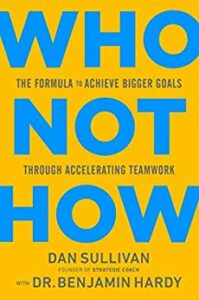 Who Not How (Dan Sullivan & Benjamin Hardy) – The challenging reality for any startup entrepreneur – including the typical financial advisor who launches their own practice – is that the first few years can be a nearly overwhelming onslaught of all the things that need to be learned to do the job. From learning how to prospect and sell, to how to do financial plans and deliver advice, to how to select and implement the right technology, to the dynamics of how to actually run an advisory business, there are a lot of “hows” to learn. At a certain point, though, defining the business by what the founding advisor can themselves learn how to do becomes limiting, as there’s no longer any more time in the day to learn how to do more, or there may simply not be any time to do more (even if you already know how). And at that point, the key to success fundamentally changes: the question of what it takes to get to the next level is no longer about “How do I accomplish this” new or different or better thing, but who… “Who can help me achieve this”? Which in turn requires a fundamental mindset shift for the business owner themselves, to transition from trying to figure out how to do everything, to trying to set the Vision for what it’s intended to be, and then spending their time finding the Whos who can make that vision happen. Or as Sullivan and Hardy explain it: “The more explicit you are in what you want, the faster you’ll attract the right Whos to help you achieve that vision. The leader explains the ‘What’ and ‘Why’ and then allows the ‘Who’ to execute the ‘How’”! Which then can rely upon the time and expertise of the Who to complete that new goal, vision, or project (freeing up the founder/leader’s time for the next idea, the next vision, and finding the next Who to achieve it). The irony, though, is that early on, most of us are taught that getting help from others is “cheating” (literally, when it comes to schoolwork!), and the advisor business, in particular, tends to celebrate the rugged individualism of advisors who grow themselves individually to enormous levels of production and success. Even though, in the end, solo advisors inevitably hit a capacity wall, and it's only those who can embrace collaboration and expanding the team that grow through it (a point that Sullivan and Hardy make very effectively, in myriad ways, throughout the book). The starting point, though, is simply to recognize that when you stop asking “How do I do this in my business?” and instead start asking “Who can help me achieve this?”, you begin to take a fundamentally different approach to growth that can unlock the next level of success.
Who Not How (Dan Sullivan & Benjamin Hardy) – The challenging reality for any startup entrepreneur – including the typical financial advisor who launches their own practice – is that the first few years can be a nearly overwhelming onslaught of all the things that need to be learned to do the job. From learning how to prospect and sell, to how to do financial plans and deliver advice, to how to select and implement the right technology, to the dynamics of how to actually run an advisory business, there are a lot of “hows” to learn. At a certain point, though, defining the business by what the founding advisor can themselves learn how to do becomes limiting, as there’s no longer any more time in the day to learn how to do more, or there may simply not be any time to do more (even if you already know how). And at that point, the key to success fundamentally changes: the question of what it takes to get to the next level is no longer about “How do I accomplish this” new or different or better thing, but who… “Who can help me achieve this”? Which in turn requires a fundamental mindset shift for the business owner themselves, to transition from trying to figure out how to do everything, to trying to set the Vision for what it’s intended to be, and then spending their time finding the Whos who can make that vision happen. Or as Sullivan and Hardy explain it: “The more explicit you are in what you want, the faster you’ll attract the right Whos to help you achieve that vision. The leader explains the ‘What’ and ‘Why’ and then allows the ‘Who’ to execute the ‘How’”! Which then can rely upon the time and expertise of the Who to complete that new goal, vision, or project (freeing up the founder/leader’s time for the next idea, the next vision, and finding the next Who to achieve it). The irony, though, is that early on, most of us are taught that getting help from others is “cheating” (literally, when it comes to schoolwork!), and the advisor business, in particular, tends to celebrate the rugged individualism of advisors who grow themselves individually to enormous levels of production and success. Even though, in the end, solo advisors inevitably hit a capacity wall, and it's only those who can embrace collaboration and expanding the team that grow through it (a point that Sullivan and Hardy make very effectively, in myriad ways, throughout the book). The starting point, though, is simply to recognize that when you stop asking “How do I do this in my business?” and instead start asking “Who can help me achieve this?”, you begin to take a fundamentally different approach to growth that can unlock the next level of success.
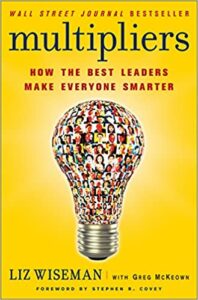 Multipliers: How The Best Leaders Make Everyone Smarter (Liz Wiseman & Greg McKeown) – With the rise of the industrial revolution, businesses experienced a ‘productivity miracle’ as the systematization of factories and machinery operated by humans began to achieve far more than humans alone ever could, and spawned a growing series of business and leadership books about how to further maximize those productivity gains. But as technology and automation reach the point where many of these systems can operate largely autonomously, human beings are increasingly moving into the domains of “knowledge workers”, who ultimately produce goods and services at a level above and beyond what the technology alone can provide (e.g., what a comprehensive financial planner does beyond what a robo-advisor alone can automate)… which means the modern productivity challenge is not necessarily about how to better leverage technology, per se, but how to better leverage people themselves. As there’s an immense difference between getting a lot of work out of an employee, and getting someone’s best work, leading to the phenomenon that in many businesses today, team members are simultaneously overworked and still under-utilized. Accordingly, Wiseman and McKeown explore the common traits of leaders who are able to get the most out of their people – dubbed “Multipliers” – and how they’re distinct from “Diminishers” (who tend to put themselves at the center of the process and limit the growth and success of their team in the process). In essence, Diminishers approach business problems with the worldview that “they’ll never figure this out without me”, while Multipliers have the mindset of “[our] people are smart and will figure this out”, and in turn focus on attracting talented people, creating an environment where they can do their best work, challenging them to stretch their capabilities, encouraging rigorous debate to fully flesh out ideas, and then invest into their teams and hold them accountable (which in practice means Multipliers are results-driven and achieve a lot, but aren’t necessarily “feel-good” managers and in fact can have a “hard edge” as they demand so much from their teams). The key insight, though, is simply that if your business isn’t achieving the productivity and profits that are desired, often the key is not to grow further or try to reach new economies of scale, but instead turning an eye inwards to see if there’s a way to get more out of the people already on the team by creating a better environment for them to do and achieve more?
Multipliers: How The Best Leaders Make Everyone Smarter (Liz Wiseman & Greg McKeown) – With the rise of the industrial revolution, businesses experienced a ‘productivity miracle’ as the systematization of factories and machinery operated by humans began to achieve far more than humans alone ever could, and spawned a growing series of business and leadership books about how to further maximize those productivity gains. But as technology and automation reach the point where many of these systems can operate largely autonomously, human beings are increasingly moving into the domains of “knowledge workers”, who ultimately produce goods and services at a level above and beyond what the technology alone can provide (e.g., what a comprehensive financial planner does beyond what a robo-advisor alone can automate)… which means the modern productivity challenge is not necessarily about how to better leverage technology, per se, but how to better leverage people themselves. As there’s an immense difference between getting a lot of work out of an employee, and getting someone’s best work, leading to the phenomenon that in many businesses today, team members are simultaneously overworked and still under-utilized. Accordingly, Wiseman and McKeown explore the common traits of leaders who are able to get the most out of their people – dubbed “Multipliers” – and how they’re distinct from “Diminishers” (who tend to put themselves at the center of the process and limit the growth and success of their team in the process). In essence, Diminishers approach business problems with the worldview that “they’ll never figure this out without me”, while Multipliers have the mindset of “[our] people are smart and will figure this out”, and in turn focus on attracting talented people, creating an environment where they can do their best work, challenging them to stretch their capabilities, encouraging rigorous debate to fully flesh out ideas, and then invest into their teams and hold them accountable (which in practice means Multipliers are results-driven and achieve a lot, but aren’t necessarily “feel-good” managers and in fact can have a “hard edge” as they demand so much from their teams). The key insight, though, is simply that if your business isn’t achieving the productivity and profits that are desired, often the key is not to grow further or try to reach new economies of scale, but instead turning an eye inwards to see if there’s a way to get more out of the people already on the team by creating a better environment for them to do and achieve more?
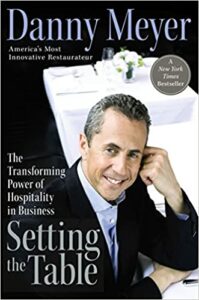 Setting the Table: The Transforming Power Of Hospitality In Business (Danny Meyer) – The traditional view of the restaurant business is that it’s a food business, one where the providers of the best food (or at least, the best-valued food for its cost) will be the winners. But famed restauranteur Danny Meyer (of Union Square Hospitality Group, and multiple award-winning New York City restaurants, in addition to founding Shake Shack) makes the case that the foundation of a successful restaurant isn’t its food, but its hospitality. Because as Meyer puts it, “within moments of being born, most babies find themselves receiving the first four gifts of life: eye contact, a smile, a hug, and some food… that first time may be the purest ‘hospitality transaction’ we’ll ever have, and it’s not much of a surprise that we’ll crave those gifts for the rest of our lives.” More generally, Meyer suggests that hospitality (for the guest or customer or client) is what comes about when you believe the other person is on your side, and when something good happens for you (not to you, but for you). In other words, hospitality is about personal connection and personalization. In turn, Meyer has coined his own version of “Enlightened Hospitality” that focuses on all stakeholders, including employees, guests, community, suppliers, and investors (in that order), and shares the principles that he’s used to build his renowned hospitality across all of his restaurants. From the advisor’s perspective, though, the power of Setting The Table is simply what comes from reading Meyer’s own story and experiences, and reflecting on what it would mean to treat an advisory business – which similarly forms long-term and lifelong relationships with its clients, the same way that a restaurant aims to do with its key customers – as a hospitality business. Which starts with really getting to know the client and capturing the key information about their preferences (e.g., their habits, the kind of food or drink they like, and any other tidbits of information that can be gathered and then reflected back to them later to build connection), while investing heavily into the team that you have to serve clients (which Meyer suggests should be 49% technical skills, and 51% the emotional connection skills that ensure anyone and everyone on the team can really connect with their guests/clients). So are you making sure your team is happy so that they’ll take care of the clients, and do you treat your clients as customers, or with the hospitality of (valued) guests?
Setting the Table: The Transforming Power Of Hospitality In Business (Danny Meyer) – The traditional view of the restaurant business is that it’s a food business, one where the providers of the best food (or at least, the best-valued food for its cost) will be the winners. But famed restauranteur Danny Meyer (of Union Square Hospitality Group, and multiple award-winning New York City restaurants, in addition to founding Shake Shack) makes the case that the foundation of a successful restaurant isn’t its food, but its hospitality. Because as Meyer puts it, “within moments of being born, most babies find themselves receiving the first four gifts of life: eye contact, a smile, a hug, and some food… that first time may be the purest ‘hospitality transaction’ we’ll ever have, and it’s not much of a surprise that we’ll crave those gifts for the rest of our lives.” More generally, Meyer suggests that hospitality (for the guest or customer or client) is what comes about when you believe the other person is on your side, and when something good happens for you (not to you, but for you). In other words, hospitality is about personal connection and personalization. In turn, Meyer has coined his own version of “Enlightened Hospitality” that focuses on all stakeholders, including employees, guests, community, suppliers, and investors (in that order), and shares the principles that he’s used to build his renowned hospitality across all of his restaurants. From the advisor’s perspective, though, the power of Setting The Table is simply what comes from reading Meyer’s own story and experiences, and reflecting on what it would mean to treat an advisory business – which similarly forms long-term and lifelong relationships with its clients, the same way that a restaurant aims to do with its key customers – as a hospitality business. Which starts with really getting to know the client and capturing the key information about their preferences (e.g., their habits, the kind of food or drink they like, and any other tidbits of information that can be gathered and then reflected back to them later to build connection), while investing heavily into the team that you have to serve clients (which Meyer suggests should be 49% technical skills, and 51% the emotional connection skills that ensure anyone and everyone on the team can really connect with their guests/clients). So are you making sure your team is happy so that they’ll take care of the clients, and do you treat your clients as customers, or with the hospitality of (valued) guests?
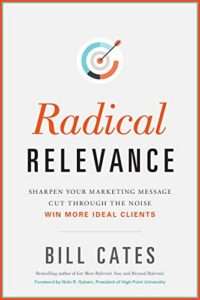 Radical Relevance: Sharpen Your Marketing Message, Cut Through The Noise, And Win More Ideal Clients (Bill Cates) – The average person is exposed to more than 3,000 marketing messages every day, or an average of 3 messages per minute, from banner ads on websites to display ads in magazines and on billboards to embedded advertising in the shows we watch or the content we read. And in a sea of advertising overwhelm, most consumers have long since attuned their brains to tune all of it out. To the point that Cates suggests if what you’re offering isn’t “radically relevant” at the exact moment it’s seen, it will simply be glossed over, and if the solution is not “critically compelling” to that specific individual then it isn’t likely to overcome their inertia and drive them to action (e.g., to engage you for advice). Notably, though, being so relevant in turn means getting crystal clear on who the ideal “Right-Fit Client” really is, because in practice what is relevant for one type of prospective client may be completely irrelevant for another, from in-person meetings (a plus for the shop-local-oriented retiree but a negative to the globetrotting retiree who would prefer an advisor they can meet with entirely virtually while traveling the world) to charging AUM firms (a plus for the retiree with significant accumulated retirement assets but a negative for the up-and-coming wealth builder who has a strong income but no assets [yet]), to more specialized services like being able to do a detailed stock option analysis and annual in-depth AMT planning (great if clients are key employees at tech companies, but not so relevant for retirees who already cashed out from them). In fact, a key point of becoming “radically relevant” is first to decide who you will be radically relevant for, in order to better understand not just the value the firm provides, but how prospective clients interpret that value for themselves (or not). In practice, Cates “Radical Relevance” will be most useful for advisors who are operating as generalists but struggling with their marketing and differentiation in a sea of sameness and both still need to be convinced that it’s better to get narrower (or not) and then get some tactics on how to do it, though advisors who already have a more niche focus will still find the second half of the book (on specific tactics) to be helpful in gleaning a few key takeaways and action items to try out for themselves (from storytelling to social proof to creating a greater sense of urgency in prospects to drive them to take action).
Radical Relevance: Sharpen Your Marketing Message, Cut Through The Noise, And Win More Ideal Clients (Bill Cates) – The average person is exposed to more than 3,000 marketing messages every day, or an average of 3 messages per minute, from banner ads on websites to display ads in magazines and on billboards to embedded advertising in the shows we watch or the content we read. And in a sea of advertising overwhelm, most consumers have long since attuned their brains to tune all of it out. To the point that Cates suggests if what you’re offering isn’t “radically relevant” at the exact moment it’s seen, it will simply be glossed over, and if the solution is not “critically compelling” to that specific individual then it isn’t likely to overcome their inertia and drive them to action (e.g., to engage you for advice). Notably, though, being so relevant in turn means getting crystal clear on who the ideal “Right-Fit Client” really is, because in practice what is relevant for one type of prospective client may be completely irrelevant for another, from in-person meetings (a plus for the shop-local-oriented retiree but a negative to the globetrotting retiree who would prefer an advisor they can meet with entirely virtually while traveling the world) to charging AUM firms (a plus for the retiree with significant accumulated retirement assets but a negative for the up-and-coming wealth builder who has a strong income but no assets [yet]), to more specialized services like being able to do a detailed stock option analysis and annual in-depth AMT planning (great if clients are key employees at tech companies, but not so relevant for retirees who already cashed out from them). In fact, a key point of becoming “radically relevant” is first to decide who you will be radically relevant for, in order to better understand not just the value the firm provides, but how prospective clients interpret that value for themselves (or not). In practice, Cates “Radical Relevance” will be most useful for advisors who are operating as generalists but struggling with their marketing and differentiation in a sea of sameness and both still need to be convinced that it’s better to get narrower (or not) and then get some tactics on how to do it, though advisors who already have a more niche focus will still find the second half of the book (on specific tactics) to be helpful in gleaning a few key takeaways and action items to try out for themselves (from storytelling to social proof to creating a greater sense of urgency in prospects to drive them to take action).
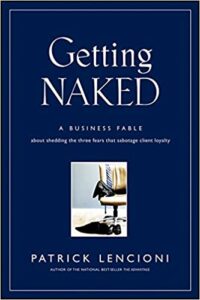 Getting Naked: A Business Fable About The Three Fears That Sabotage Client Loyalty (Patrick Lencioni) – One of the biggest challenges that newer financial advisors face is how to convince prospective clients to actually pay them for their financial advice… a delicate dance of trying to show the prospect enough value that they will want to pay, but not so much that they feel like they’ve already gotten all the value and won’t need to pay. Yet in practice, this “Fear of Losing the Business” can quickly become a self-fulfilling prophecy, where the advisor holds back so much of their value out of fear of giving too much away, that they never show enough value to get the client in the first place. In “Getting Naked”, Lencioni tells the story of a hypothetical consultant who is learning to sell their own consulting (advice) services, and has to learn how to get comfortable with the “Naked Service” approach of their new firm, which is all about making themselves vulnerable to the client, which both stokes our fears even as the vulnerability also becomes the foundation of a strong relationship. Which means instead of being fearful about losing the business (and holding back), instead lean in to start giving away the business (e.g., treat the first prospect meeting as though it was the first client meeting, and just begin to give them the value… because if it’s really valuable, they’ll just want to hire the advisor to get to the next meeting where they can get even more of the value they’re already receiving). And instead of being fearful of being embarrassed, have the vulnerability to ask the “dumb” questions and make the “dumb” suggestions (because in practice, what may seem obvious or “dumb” to you may be the key issue that the client simply never realized, and in the end the client won’t remember the “dumb” questions that didn’t matter, just the big question that did matter and changed everything). And instead of being fearful about feeling inferior (imposter syndrome!?), recognize that by taking a strong interest in the client and making them feel heard and understood, they’ll feel so appreciated that they’ll welcome the advisor further into their lives. Of course, the reality is that many of these tactics are far easier said than done, but Lencioni’s storytelling approach – through a fable featuring a consultant who shares many of the same fears and concerns as the average advisor – provides a powerful mechanism to help us see that sometimes our own fears are our own worst enemy, and that once you assume that clients will want and need your help because you have something valuable to share, the sooner you start just doing it for them (instead of holding back), the faster they’ll want to engage you to do so on an ongoing basis!
Getting Naked: A Business Fable About The Three Fears That Sabotage Client Loyalty (Patrick Lencioni) – One of the biggest challenges that newer financial advisors face is how to convince prospective clients to actually pay them for their financial advice… a delicate dance of trying to show the prospect enough value that they will want to pay, but not so much that they feel like they’ve already gotten all the value and won’t need to pay. Yet in practice, this “Fear of Losing the Business” can quickly become a self-fulfilling prophecy, where the advisor holds back so much of their value out of fear of giving too much away, that they never show enough value to get the client in the first place. In “Getting Naked”, Lencioni tells the story of a hypothetical consultant who is learning to sell their own consulting (advice) services, and has to learn how to get comfortable with the “Naked Service” approach of their new firm, which is all about making themselves vulnerable to the client, which both stokes our fears even as the vulnerability also becomes the foundation of a strong relationship. Which means instead of being fearful about losing the business (and holding back), instead lean in to start giving away the business (e.g., treat the first prospect meeting as though it was the first client meeting, and just begin to give them the value… because if it’s really valuable, they’ll just want to hire the advisor to get to the next meeting where they can get even more of the value they’re already receiving). And instead of being fearful of being embarrassed, have the vulnerability to ask the “dumb” questions and make the “dumb” suggestions (because in practice, what may seem obvious or “dumb” to you may be the key issue that the client simply never realized, and in the end the client won’t remember the “dumb” questions that didn’t matter, just the big question that did matter and changed everything). And instead of being fearful about feeling inferior (imposter syndrome!?), recognize that by taking a strong interest in the client and making them feel heard and understood, they’ll feel so appreciated that they’ll welcome the advisor further into their lives. Of course, the reality is that many of these tactics are far easier said than done, but Lencioni’s storytelling approach – through a fable featuring a consultant who shares many of the same fears and concerns as the average advisor – provides a powerful mechanism to help us see that sometimes our own fears are our own worst enemy, and that once you assume that clients will want and need your help because you have something valuable to share, the sooner you start just doing it for them (instead of holding back), the faster they’ll want to engage you to do so on an ongoing basis!
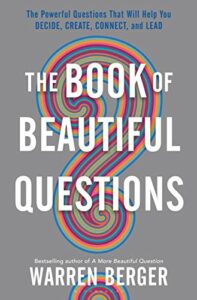 The Book Of Beautiful Questions: The Powerful Questions That Will Help You Decide, Create, Connect, And Lead (Warren Berger) – Most business books try to provide answers, ‘ideally’ encapsulated in simple acronyms that can be easily remembered and applied. Yet the reality is that more often, the real key to success is not in finding better answers, but asking better questions in the first place, from innovation (that is often stoked by a visionary who asks a unique question about how the world works and then creates value by answering it) to better decision-making (which involves asking critical questions to get to the ‘right’ answer in the first place). In fact, the average 4-year-old asks anywhere from 100 to 300 questions every day, as they seek to better understand the world around them… until eventually, our frequency of question-asking declines, impacted by the “five enemies of questioning” (fear, knowledge, bias, hubris, and time). Accordingly, Berger – as a self-professed “Questionologist” – explores how we can get more comfortable with and ask better questions, along four key domains: decision-making (as good critical thinking is rooted in asking good critical questions to work through our own biases and blind spots); creativity (the kinds of “Why” and “What-If” questions that fire the imagination); connecting (as research shows we become more likable to others when we ask them more [of the right types of] questions); and leadership (asking the ambitious, unexpected questions no one else is asking). What’s unique about Berger’s book, though, is that it doesn’t merely encourage us to be better questioners; it actually gives thought-provoking questions along a wide range of dimensions, from decision-making (instead of just reflecting on what you know, as “why do I believe what I believe?” and consider “what if the opposite is true?” and “would I rather be right, or would I rather understand?”), to creativity questions (don’t pressure yourself to come up with the big idea for your business, and instead ask “what stirs me”, “what bugs me”, “what’s missing”, and “what do I keep coming back to?”). Of particular interest to advisors, though, will be Part III of the book, which provides a number of thought-provoking questions to help connect with others (i.e., clients!), so instead of just asking “how are you” try asking “what’s the best thing that happened to you today?” or “what are you excited about in your life right now?”, instead of “what do you do” consider “what are you most passionate about?”, and instead of “how was your day?” try “how can I make your day easier in five minutes?” and “if you were leaving on a vacation tonight, where do you wish you were heading?” And so for all those financial advisors looking for more inspiration about better questions to ask clients and prospects to connect with them, “The Book Of Beautiful Questions” provides a number of great prompts to get started (and a lot of good background on what it really means to ask good and better questions!).
The Book Of Beautiful Questions: The Powerful Questions That Will Help You Decide, Create, Connect, And Lead (Warren Berger) – Most business books try to provide answers, ‘ideally’ encapsulated in simple acronyms that can be easily remembered and applied. Yet the reality is that more often, the real key to success is not in finding better answers, but asking better questions in the first place, from innovation (that is often stoked by a visionary who asks a unique question about how the world works and then creates value by answering it) to better decision-making (which involves asking critical questions to get to the ‘right’ answer in the first place). In fact, the average 4-year-old asks anywhere from 100 to 300 questions every day, as they seek to better understand the world around them… until eventually, our frequency of question-asking declines, impacted by the “five enemies of questioning” (fear, knowledge, bias, hubris, and time). Accordingly, Berger – as a self-professed “Questionologist” – explores how we can get more comfortable with and ask better questions, along four key domains: decision-making (as good critical thinking is rooted in asking good critical questions to work through our own biases and blind spots); creativity (the kinds of “Why” and “What-If” questions that fire the imagination); connecting (as research shows we become more likable to others when we ask them more [of the right types of] questions); and leadership (asking the ambitious, unexpected questions no one else is asking). What’s unique about Berger’s book, though, is that it doesn’t merely encourage us to be better questioners; it actually gives thought-provoking questions along a wide range of dimensions, from decision-making (instead of just reflecting on what you know, as “why do I believe what I believe?” and consider “what if the opposite is true?” and “would I rather be right, or would I rather understand?”), to creativity questions (don’t pressure yourself to come up with the big idea for your business, and instead ask “what stirs me”, “what bugs me”, “what’s missing”, and “what do I keep coming back to?”). Of particular interest to advisors, though, will be Part III of the book, which provides a number of thought-provoking questions to help connect with others (i.e., clients!), so instead of just asking “how are you” try asking “what’s the best thing that happened to you today?” or “what are you excited about in your life right now?”, instead of “what do you do” consider “what are you most passionate about?”, and instead of “how was your day?” try “how can I make your day easier in five minutes?” and “if you were leaving on a vacation tonight, where do you wish you were heading?” And so for all those financial advisors looking for more inspiration about better questions to ask clients and prospects to connect with them, “The Book Of Beautiful Questions” provides a number of great prompts to get started (and a lot of good background on what it really means to ask good and better questions!).
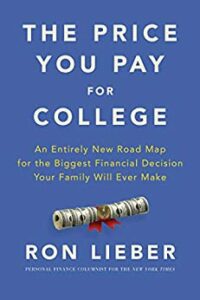 The Price You Pay For College (Ron Lieber) – For most families, the price of a college education is the third-largest expense the parents will ever face, behind only the cost of retirement and buying a house (and for larger families, the house may be less expensive than college for multiple children!). Yet, as Lieber notes, in practice we leave this monumental, often-six-figure decision about college to… a teenager, who has little if any knowledge or skill in how to choose what will be the best ‘investment’ in their education (i.e., which school will produce the best career opportunity or earning power), and little guidance in how to even evaluate the price tag. In “The Price You Pay For College”, Lieber does a deep dive into the modern college system, from the current pricing and cost structure (hint: very, very few people ever actually pay the list price for college, and “merit” scholarships at some schools are given to the majority of all applicants in what is really a standardized form of discounting from the list rate), to how to evaluate the Value that college provides (from the career opportunities it yields, to the personal growth and development it provides, to the social networks and even future-spouse connections it creates), to tips in how to better manage the cost (hint: community college as a pathway to undergrad is more challenging than most realize, and Gap Years are on the rise), and even what to look for when going through the process of evaluating school websites and touring college campuses (from where to find all the merit aid data to the current popularity of independent college counselors and how to have the “college money talk” with teenage children). For parents who haven’t been to college themselves in 20+ years, Lieber’s book provides a valuable perspective on how much has changed in the world of college applications, admissions, cost, and value (which is invaluable for financial advisors staring down the decision for their own children), but also provides an incredibly valuable perspective for advisors who commonly wok with clients that have teenagers and may be seeking the advisor’s advice on their third-largest financial decision themselves.
The Price You Pay For College (Ron Lieber) – For most families, the price of a college education is the third-largest expense the parents will ever face, behind only the cost of retirement and buying a house (and for larger families, the house may be less expensive than college for multiple children!). Yet, as Lieber notes, in practice we leave this monumental, often-six-figure decision about college to… a teenager, who has little if any knowledge or skill in how to choose what will be the best ‘investment’ in their education (i.e., which school will produce the best career opportunity or earning power), and little guidance in how to even evaluate the price tag. In “The Price You Pay For College”, Lieber does a deep dive into the modern college system, from the current pricing and cost structure (hint: very, very few people ever actually pay the list price for college, and “merit” scholarships at some schools are given to the majority of all applicants in what is really a standardized form of discounting from the list rate), to how to evaluate the Value that college provides (from the career opportunities it yields, to the personal growth and development it provides, to the social networks and even future-spouse connections it creates), to tips in how to better manage the cost (hint: community college as a pathway to undergrad is more challenging than most realize, and Gap Years are on the rise), and even what to look for when going through the process of evaluating school websites and touring college campuses (from where to find all the merit aid data to the current popularity of independent college counselors and how to have the “college money talk” with teenage children). For parents who haven’t been to college themselves in 20+ years, Lieber’s book provides a valuable perspective on how much has changed in the world of college applications, admissions, cost, and value (which is invaluable for financial advisors staring down the decision for their own children), but also provides an incredibly valuable perspective for advisors who commonly wok with clients that have teenagers and may be seeking the advisor’s advice on their third-largest financial decision themselves.
If you’re still looking for more book ideas, be certain to also check out our prior summer reading lists, along with our overall list of recommended books for financial advisors. They may be lists we've published in the past, but if you haven’t read the books yet, they're still new to you! 🙂
Top Must-Read Books for Financial Planners
2020 Summer Reading List of “Best Books” For Financial Advisors
2019 Summer Reading List of “Best Books” For Financial Advisors
2018 Summer Reading List of “Best Books” For Financial Advisors
2017 Summer Reading List of “Best Books” For Financial Advisors
2016 Summer Reading List of “Best Books” For Financial Advisors
2015 Summer Book List For Financial Advisors
2014 Summer Reading List Of Best Books For Financial Advisors
2013 Summer Reading List Of Top Financial Advisor Books
So what do you think? Will you be reading any of these books over the summer? Do you have any suggestions of your own that you’re willing to share? Please share your own great reads in the comments below!





I love that 5 of these are on Libby as audiobook, 3 are on Libby to read (with NYPL Card), and only 1 I’d have to find elsewhere (and that is only $10 on Kindle).
Thank you Michael! Great selection! Need now to cope with the other “distractions”-:)
https://www.kitces.com/blog/summer-reading-list-best-books-financial-advisors-must-read-2021-edition/